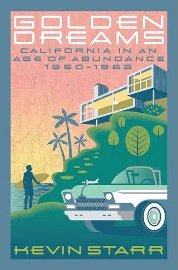
Golden Dreams: California in an Age of Abundance, 1950-1963 (Americans and the California Dream)
by Kevin Starr
-Reviewed by Byron Perry
California in the 1950s is collectively remembered as a collage of tailfins, swimming pools, and modernist architecture, a time when any hardworking sap could own a single-family home in the suburbs, complete with good schools and a mall to drive to on Saturdays.
USC historian and former California state librarian Kevin Starr assiduously delves into this gilded age, which he extends to John F. Kennedy’s assassination in 1963, in Golden Dreams, the eighth and final book in his Americans and the California Dream series. In previous volumes, Starr explored growth periods like the Gold Rush and the dot-com bubble before it burst, but no era has had more of an impact on California than the ’50s. The Golden State underwent the biggest boom of rising prosperity in American history – perhaps in all modern history – during the decade, transforming from an agricultural and provincial Western state to one of the biggest and most important economies in the world.
San Fernando Valley developed, mazes of freeways appeared across the Bay Area and Los Angeles, the Giants and Dodgers moved to the West Coast, and California voters approved “the most ambitious water storage and distribution system in the history of the human race.” These are just some of the game-changing events that Starr tackles in Golden Dreams, with a dense and fact-crammed style.
Starr likes to examine history through the movers and shakers. In a chapter on Los Angeles, the historian deftly intertwines the stories of how four people – Archbishop James Francis Cardinal McIntyre, Los Angeles Police Chief William Parker, baseball entrepreneur Walter O’Malley, and philanthropist Dorothy Chandler – transformed Los Angeles from regional hub to “supercity.” With disparate visions of modernity, but similar titanic forces of will, these four leaders permanently altered culture and society in their city. McIntyre revamped and expanded the Catholic church; Parker modernized the spectacularly corrupt LAPD (though racism remained rampant); O’Malley brought the Dodgers to L.A. and built them a stadium; and Chandler was responsible for the funding and creation of the world-class Music Center on Bunker Hill.
Starr humanizes history by looking at events this way. We learn, for example, that Parker was an incredibly cranky guy with a booze problem, and that Chandler married into that powerful clan with a chip on her shoulder for being a middle-class girl from Long Beach. But besides these little interesting details, Starr expounds on the real and lasting effects these people had on Los Angeles. Parker militarized the police force and revamped the academy. And Chandler’s fundraising efforts for the Music Center forever changed the dynamic between Hancock Park WASPs and Westside Jews, easing tensions between the two communities.
Starr tends to glorify the ’50s in Dreams, but he does sometimes make insightful points about those who were left behind during California’s furious growth. Writing about the San Fernando Valley’s boom, he points out the hypocrisy of the Los Angeles power structure – including the City Council, the Chamber of Commerce, and the Los Angeles Times – that denounced subsidized public housing as communist while praising state and federal programs that facilitated and financed single-family home ownership. “Thus the poor, the majority of them disadvantaged minorities,” he explains, “were being excluded from the same government assistance that was bringing millions of middle-class Americans, veterans especially, into home ownership.”
In light of California’s latest fiscal woes, Golden Dreams seems especially timely and pertinent. Reading about how rapidly the state expanded into the modern “global commonwealth” it is today, it’s hard not to wonder what steps could have been taken then to avoid the quandary we’re in now. It’s a “what if” that Starr chooses not to ponder; he withholds much judgment in Dreams, choosing instead to lay down the facts, and lots of them. Golden Dreams, and the whole Americans and the California Dream series, is about as complete a social, political, and cultural history as a state could ask for.
Excerpt: “As Election Day, 8 November 1960, approached, first-term governor Pat Brown was busy persuading the voters of California to pass Proposition 1, authorizing a $1.75 billion bond issue for the construction of a seven-hundred-mile State Water Project – dams, reservoirs, aqueducts, tunnels, hydroelectrical and pumping stations -to be built across the next two decades. All things considered, Proposition 1 was asking for the most ambitious water storage and distribution system in the history of the human race, and as such it was a tough sell, even for such a masterful salesman as Brown. The magnitude of the project, moving the waters of the north southward into Southern California, clashed headlong with the sectional feeling that continued to characterize the state. Nowhere, for example, was opposition to Proposition 1 stronger than in Brown’s hometown of San Francisco, where the Chronicle lambasted the proposal almost daily as a water-grab by the Southland, depicting Brown in one cartoon as a bespectacled octopus asking a voter to sign a blank check. Given the high self-regard of the Bay Area, and the water-sufficient success of the Hetch Hetchy and East Bay Utility systems, the opposition of the Chronicle made a certain sense, as did the wholesale endorsement of the measure by the Los Angeles Times, whose readers desperately needed water.”
Further Reading: Material Dreams: Southern California through the 1920s (Americans & the California Dream) and Los Angeles: Biography of a City




Send A Letter To the Editors